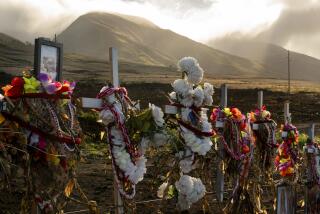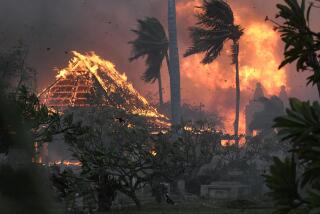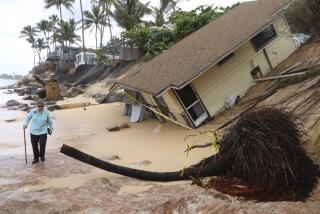POLITICS : U.S. Floats Offer to Hawaii of Some Far-Flung Islands : Washington wants to give state control of seven tiny Pacific territories. Honolulu ponders the opportunities, liabilities.
- Share via
HONOLULU — A bill before Congress would extend Hawaii’s borders more than 2,000 miles across the Pacific, from the renowned battle site of Midway to a lush, coconut-fringed hideaway called Palmyra.
The expanded version of the 50th state also would include Johnston Atoll, home of the world’s largest chemical weapons incinerator. And that makes some state officials wary of the offer.
The proposal to transfer several Pacific islands to Hawaii’s jurisdiction is part of a plan to abolish the Interior Department’s Office of Territorial and International Affairs, a move backed by the Republican majority in Congress and the Clinton Administration. The office is no longer needed, they contend, since most territories, such as Guam, are now self-governing.
Hawaii would gain jurisdiction over seven unincorporated territories administered by the U.S. government. Along with Midway, Johnston and Palmyra atolls, they are Baker, Jarvis and Howland islands and submerged Kingman Reef.
The move doesn’t add up to much in terms of population or landmass. Only Midway and Johnston are inhabited, with fewer than 2,000 people between them. Altogether, the territories boast just seven square miles of land. Three miles of sea surrounding each of them also would go to the state.
But while it falls short of the Louisiana Purchase, the novel notion of expanding this oceanic state interests Gov. Ben Cayetano, who would have the right to accept or reject the offer.
“The potential is tremendous,” he said recently, pointing to eco-tourism, fishing, undersea mining and even a low-security prison as possible options. “We are putting together a fact-finding team to explore the economic opportunities.”
But Democratic Reps. Patsy T. Mink and Neil Abercrombie of Hawaii question what liabilities might come along with the new territory, from environmental cleanup to law enforcement.
“I don’t see any advantage for Hawaii,” Mink said. “We would have to assume a lot of responsibility, financial and otherwise. I have numerous problems with the use of Johnston Atoll.”
Precisely what Hawaii would get out of the deal is not clear. Introduced by Rep. Elton Gallegly (R-Simi Valley), the Insular Areas Consolidation Act would transfer jurisdiction but not title. Most of the islands would remain federal property and continue to be managed by the U.S. government.
Legal experts are trying to sort out just what the implications are, before the legislation advances. Hawaii could gain some say in activities on or near the islands, and the right to levy taxes. Making the territories formally part of a state might strengthen U.S. claims to the 200-mile exclusive economic zone around them.
“This legislation makes sense based on history and geography,” said Jim Maiella, Gallegly’s spokesman. “It is not our intent to transfer financial liability. There’s no hidden agenda.”
Midway and privately owned Palmyra seem to offer the most potential. Strategically located halfway between Japan and California, roughly 1,150 miles northwest of Honolulu, Midway witnessed the naval battle that turned the tide of World War II in the Pacific and has long served as a military base and national wildlife refuge.
The Navy now is shutting down its Midway Air Facility and cleaning up the atoll to hand it over to the U.S. Fish and Wildlife Service--which in turn is soliciting proposals from private operators for eco-tourism activities.
The atoll is home to more than a million sea birds, including the world’s largest colony of Laysan albatross, or gooney birds, and provides critical habitat for the endangered Hawaiian monk seal. Green sea turtles and dolphins frequent its waters.
Palmyra Atoll, the private property of the Fullard-Leo family of Honolulu, has been uninhabited for decades, but developer Peter Savio has leased Palmyra and plans to clear its overgrown, 6,000-foot airstrip over the next several months to start commercial fishing operations. He also envisions a “get away from it all” resort.
The other territories involved are less inviting. Baker, Jarvis and Howland, coral islands 1,300 to 1,600 miles southwest of Honolulu, are so dry and remote that nothing but sea birds uses them. All three are national wildlife refuges, so fishing is prohibited and access restricted. Even U.S. Fish and Wildlife personnel can afford to charter a boat to visit only every other year.
Johnston, a restricted military base 825 miles from here, has regular air service but is forbidding. All visitors are handed gas masks, a nerve gas antidote and a syringe. In case of an accident at the chemical weapons incinerator, they are expected to inject themselves with the antidote.
More to Read
Sign up for Essential California
The most important California stories and recommendations in your inbox every morning.
You may occasionally receive promotional content from the Los Angeles Times.










